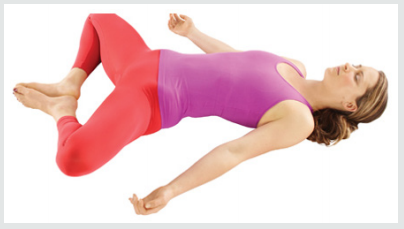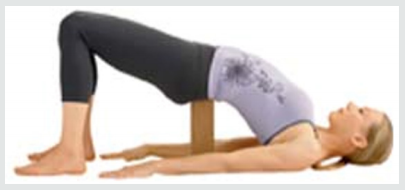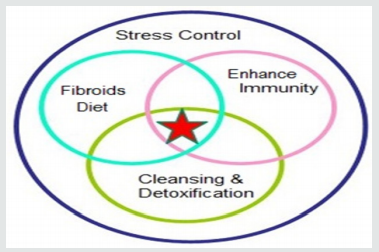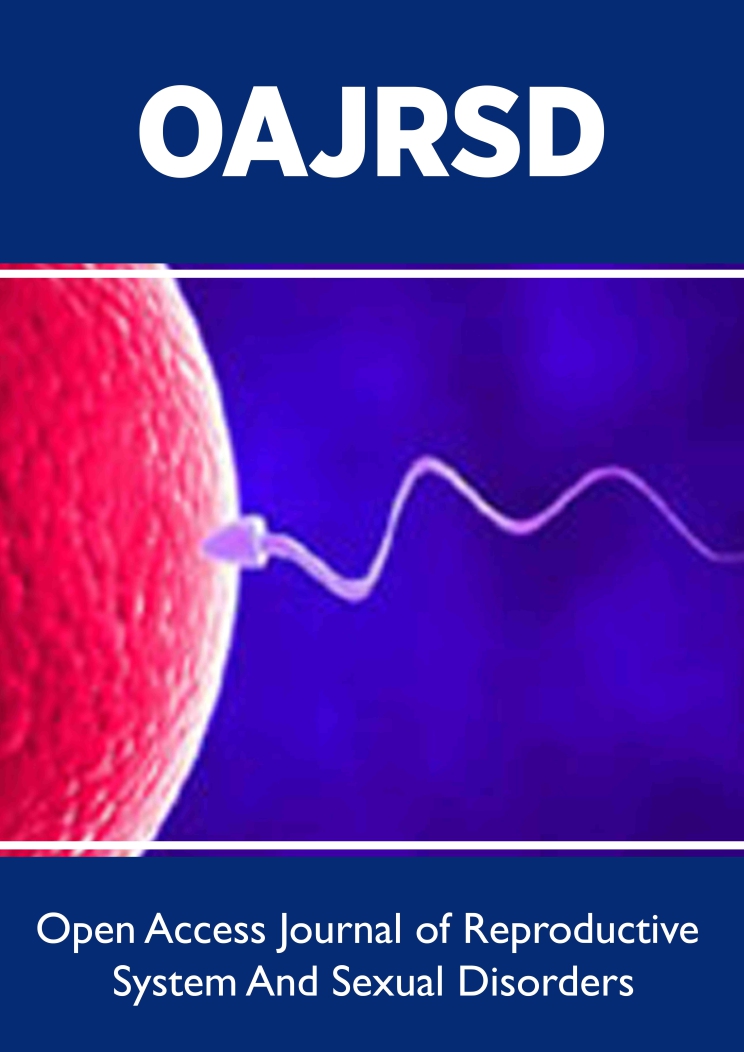
Lupine Publishers Group
Lupine Publishers
Menu
ISSN: 2641-1644
Review ArticleOpen Access
An Overall Review on The Treatment of Uterine Fibroid by Yoga Volume 2 - Issue 3
A Krishna sailaja*
- Department of Pharmacy, India
Received: April 22, 2019; Published: April 29, 2019
Corresponding author: A Krishna sailaja, Department of Pharmacy, India.
DOI: 10.32474/OAJRSD.2019.02.000140
Introduction
Fibroids are the most frequently seen tumors of the female reproductive system. Fibroids, also known as uterine myomas, leiomyomas, or fibromas, are firm, compact tumors that are made of smooth muscle cells and fibrous connective tissue that develop in the uterus. It is estimated that between 20 to 50 percent of women of reproductive age have fibroids, although not all are diagnosed. Some estimates state that up to 30 to 77 percent of women will develop fibroids sometime during their childbearing years, although only about one-third of these fibroids are large enough to be detected by a health care provider during a physical examination [1,2].
Types of Fibroids
Different fibroids develop in different locations in and on the uterus.
Intramural Fibroids
Intramural fibroids are the most common type of fibroid. These types appear within the lining of the uterus (endometrium). Intramural fibroids may grow larger and actually stretch your womb.
Subserosal Fibroids
Subserosal fibroids form on the outside of your uterus, which is called the serosa. They may grow large enough to make your womb appear bigger on one side.
i. Pedunculated Fibroids
When subserosal tumors develop a stem they become pedunculated fibroids.
ii. Submucosal Fibroids
These types of tumors develop in the inner lining (myometrium) of your uterus. Submucosal tumors are not as common as other types, but when they do develop, they may cause heavy menstrual bleeding and trouble conceiving.
Causes of Fibroid [3,4]
While it is not clearly known what causes fibroids, it is believed that each tumor develops from an aberrant muscle cell in the uterus, which multiplies rapidly because of the influence of estrogen.
A. Hormones
Estrogen and progesterone are the hormones produced by the ovaries. They cause the uterine lining to regenerate during each menstrual cycle and may stimulate the growth of fibroids.
Fibroids may run in the family. If your mother, sister, or grandmother has a history of this condition, you may develop it as well.
C. Pregnancy
Pregnancy increases the production of estrogen and progesterone in your body. Fibroids may develop and grow rapidly while you are pregnant.
Symptoms of fibroids may include:
a. heavy bleeding between or during your periods that includes blood clots
b. pain in the pelvis and/or lower back
c. increased menstrual cramping
e. pain during intercourse
f. menstruation that lasts longer than usual
g. pressure or fullness in the lower abdomen
h. swelling or enlargement of the abdomen (Figure 1).
Diagnosis of Fibroid
The presence of fibroid can be diagnosed through pelvic exam. This exam is used to check the condition, size, and shape of your uterus. There are other ways to identify the presence of fibroid.
a. Ultrasound
An ultrasound uses high frequency sound waves to produce images of uterus on a screen. This will allow the doctor to see its internal structures and any fibroids present. A transvaginal ultrasound, in which the ultrasound wand (transducer) is inserted into the vagina, may provide clearer pictures since it is closer to the uterus during this procedure.
b. Pelvic MRI
This in-depth imaging testing produces pictures of the uterus, ovaries, and other pelvic organs.
Treatment of Uterine Fibroid [5,6]
Why Should one Choose Yoga?
a) Unlike most western exercises which can exhaust the person, yoga will not do this. After yoga, the person will feel more balanced and more vital as it does not drain the energy.
b) Yoga helps to promote inner health which is also beneficial for outer health.
c) The breathing associated with yoga is to promote selfawareness as well as overall wellbeing and the breathing also helps with holding the various postures of yoga.
d) One will become stronger and more flexible which also helps with the normal aging process.
e) The level of endurance is increased.
f) One will be able to calm your mind and spirit.
g) Practicing yoga regularly will improve the mental focus which can help in the daily life.
Yoga for Fibroids [7,8]
Various eastern practices believe in the concept of energy sources present in the body and when there is an obstacle or blockage on an energy path in the body, sickness and disease arise. These energy sources are called by various names including chakras which were so defined by Indian Hindu philosophers thousands of years ago. According to those philosophers, there are seven chakras in the body that rise from the groin area to the crown of the head that are each linked to certain specific areas of the body as well as different emotions, earth elements and colors. The chakra that is commonly related to the uterus is the second chakra which is known as the sacral which is represented by the color orange. Yoga for fibroids includes postures that help to release and stimulate kundalini which is the energy that helps to unblock and balance the chakras which then helps to bring about healing and wellbeing in the body, mind and spirit which should help to eliminate the various uterine fibroids symptoms, shrink fibroids as well as prevent the development of uterine fibroids.
The sacral chakra is located in the lower abdomen and this energy is the trigger for a wide range of sensual forces such as our sexuality, spontaneity, creativity, etc, and when this energy is blocked or unbalanced, issues in this area of the body including fibroids may develop. Using various breathing and yoga postures can help to eliminate any imbalance or blockage along this energy path. The specific yoga postures that are focused on the pelvic and lower back region help to energize and oxygenate the female reproductive tract in addition to helping balance underlying hormone imbalance while improving the circulation in the pelvic region. Dr. David Rakel says that body awareness exercises may help reduce fibroid growth and symptoms. It is always better to consult doctor before practicing yoga.
Twisting Yoga Posture
There’s no evidence that twisting yoga postures will shrink your fibroids, but they may help alleviate discomfort as they help open the abdominal area and massage the lower spine, two areas that are common problems for women with uterine fibroids. In an article for Yoga Journal, certified Iyengar yoga instructor Jaki Nett suggests trying Bharadvajasana, or Bharadvaja’s Twist, and Parivrtta Janu Sirsasana, or Revolved Head-to-Knee Pos, to help open your abdomen (Figure 2).
Aerobic Exercise
Aerobic exercise has many benefits and for someone with fibroid tumors, aerobic exercise helps to balance hormones. While the exact cause of uterine fibroids is unknown, hormonal balance is thought be big part of their growth. Aerobic exercise which normalizes insulin levels helps to prevent a state of hormonal imbalance. High insulin levels is one of the ways of creating an estrogen dominant state which fibroids love and thrive upon. As fibroid grow, one’s yoga practice should be changed to accommodate them. Women with large, heavy fibroid should approach yoga as if they were pregnant. For them, supported poses like Supta Virasana (Reclining Hero Pose), Supta Baddha Konasana (Reclining Bound Angle Pose), and Salamba Setu Bandha Sarvangasana (Supported Bridge Pose) can be of great benefit.
Bharadvaja’s Twist
If you have uterine fibroids, focus on opening and softening the abdominal area to help the body accommodate fibroid growth by practicing twists like Bharadvaja’s Twist, or Bharadvajasana. To perform the twist, begin seated on your mat with your legs extended straight in front of you. Shift your weight to the right, bend your knees and then swing your legs to the left, drawing the feet toward and behind your buttocks. Breathe into the twist by inhaling, lifting through the chest and then exhaling as you twist first your torso gently to the right. Turn the neck and then the face to the right, lengthening the spine and continually breathing and lifting through the chest to intensify the twist (Figure 3).
Reclining Bound Angle Pose
For heavy menstrual periods and pain as part of thefibroid symptoms, a restorative practice - similar to the ones used by pregnant women to help ease discomfort and further open the abdomen - might help. To perform Reclining Bound Angle Pose, or Supta Baddha Konasana, begin by sitting on your mat with knees bent out to the sides and the soles of your feet touching. Place thick blankets on either side of your hips to support your thighs and bring greater ease to this restorative posture. Next, use your hands to support yourself as you lean back and then lie flat on the floor, keeping your knees bent outward and resting your bent knees on the blankets. Close the eyes, breathe deeply and focus on sending the groins deep down into the pelvis, widening the back pelvis and narrowing the front. Allow the knees to slowly and naturally move closer to the floor as one focus on their groins. Do not push the knees down actively (Figure 4).
Supported Bridge Pose
To perform the supported version of Bridge Pose, or Setu Bandha Sarvangasana, keep a block or bolster by your mat as you lie down on your back and bend your knees, drawing the feet as close to the buttocks as possible and keeping the arms straight at your sides. Exhale and push your tailbone up while pressing your feet firmly into the floor, lifting your buttocks off the ground and supporting yourself by placing the block or bolster beneath your sacrum. Draw your shoulder blades together and down your back, and maintain active thighs and arms for additional support (Figure 5).
Reclining Hero Pose
If you have uterine fibroids, you might also want to try Reclining Hero Pose, or Supta Virasana. However, it is important to note that this pose is an intermediate yoga posture and should only be practiced if you can already perform Hero Pose, a seated posture in which the buttocks sits on the floor between the feet, with relative ease. To transition from Hero Pose to Reclining Hero Pose, exhale and slowly lower your back toward the floor, using your hands and arms for support. If needed, place blankets beneath your back for added cushion and ease. Lay your arms on the floor slightly away from your body, with the palms facing upward. Keep the thighs parallel and the knees as parallel as possible. Do not allow the knees to fall any wider apart than hip’s width to prevent strain (Figure 6).
Standing Forward Bend
Standing forward bend, or uttanasana, will lift and strengthen your uterus. While in a standing position, bend your knees slightly and bend forward placing your hands on the floor, yoga blocks, or a chair. Slowly straighten your knees by lifting your tailbone up toward the ceiling. Hold for 30 to 60 seconds and repeat twice (Figure 7).
Inverted Staff Pose
Inverted staff pose, or viparita dandasana, stretches the uterus and starves fibroids of blood, preventing them from growing. Stack two yoga bolsters on top of each other against a wall. Place a foldingchair two feet in front of the bolsters and place a towel on the seat. Sit on the chair backwards, stretching your legs through the chair back. Lie backwards and respectively place your feet on the bolsters, upper back on the chair, and head on another bolster. Hang onto the legs of the chair and hold the pose for 30 to 60 seconds (Figure 8).
Instructions Diet is the Key
Overall, it is necessary to evolve the diet and the lifestyle of the client. Women who follow this programme consistently will find the growth of their myomas contained.
a. A diet high in fiber in low in fat can help with the symptoms fibroids cause. Start the day with high-fiber oatmeal and eat fruits high in fiber such as prunes, pears and figs.
b. Add soy products to diet to combat fibroids. Soy products produce isoflavones which have a weaker amount of estrogen that bind to the estrogen receptor, making stronger ominous estrogen produced in the body less available and in turn can reduce fibroids.
c. Reduce sugar intake, alcohol consumption, and foods high in saturated fats. These items make it difficult for the body to regulate hormones, making cramps and bloating increase.
d. Eat fruits and vegetables in bulk. Spinach and broccoli help stabilize estrogen levels.
e. Have a balanced regime of weekly exercise. Exercise 3 to 5 times a week for at least 30 minutes.
Diet - restrictions on the intake of red meat as well as the quantity of protein taken per meal example 4 oz. ; no dairy; reduced amount of rice; no eating after 7.30pm. He considers eating late at night to be one of the significant contributing factors to growth of the fibroids and other health problems.
Importance of Liver [9,10].
a) One of the liver’s many jobs is to break down estrogens. It has a much harder time doing this if it is detoxifying all the other substances that it is expected to tackle on a daily basis.
b) Avoid alcohol.
c) Avoid coffee.
d) To stimulate the liver one can use lemon juice, and put bitter greens such as dandelion greens, endive and radicchio in the salad.
e) one can take liver-supporting herbs including dandelion root, milk thistle, burdock, artichoke and turmeric.
f) B vitamins also aid the liver and are recommended. They can be added in the form of whole foods (such as lentils, rice bran, and blackstrap molasses) or supplements. Vitamin B6, in particular, enhances the breakdown and removal of estrogen from the body.
Holistic Method for Treating Uterine Fibroids [11]:
There are four broad components in the holistic treatment for fibroids.
a) Stress control
b) Dietary changes
c) Enhancing immunity system
d) Cleansing and elimination of toxins (Figure 9).
References
- Women’s Health Online resource
- (2004) Merck Manual of Medical Information 2nd (edn.), Simon and Shuster Co, UK.
- Patki V, How Systemic Enzymes Fight Inflammation
- Trickey Ruth (2003) Women, Hormones and The Menstrual Cycle – herbal and medical solutions from adolescence to menopause. Crows nest, Allen & Unwin, Australia.
- Weed Susun (1986) Herbal for the Childbearing Year. Woodstock, Ash Tree Publishing, New York, USA.
- Northrup, Christiane (2010) Women’s Bodies, Women’s Wisdom. Bantam Books, New York, USA.
- Hudson, Tori ND (2008) Women’s Encyclopedia of Natural Medicine. McGraw Hill Publishing, New York, USA.
- Romm Aviva (2010) Botanical Medicine for Women’s Health. St. Louis, Missouri: Churchill Livingstone Press, London.
- Uterine Fibroids ¬ Treating fibroids non¬invasively. How focused ultrasound destroys fibroids with an intact uterus.
- Dumanoski D, Peterson←Meyers J (n.d.). Widespread Pollutants with Endocrine¬disrupting Effects. Our Stolen Future.
- Chichoke A (2000) Enzymes & Enzyme Therapy ← how to jump¬start your way to lifelong good health. Second Edition. Keats Publishing, Chicago, Illinois. pp 199-200.

Top Editors
-

Mark E Smith
Bio chemistry
University of Texas Medical Branch, USA -

Lawrence A Presley
Department of Criminal Justice
Liberty University, USA -

Thomas W Miller
Department of Psychiatry
University of Kentucky, USA -

Gjumrakch Aliev
Department of Medicine
Gally International Biomedical Research & Consulting LLC, USA -

Christopher Bryant
Department of Urbanisation and Agricultural
Montreal university, USA -

Robert William Frare
Oral & Maxillofacial Pathology
New York University, USA -

Rudolph Modesto Navari
Gastroenterology and Hepatology
University of Alabama, UK -

Andrew Hague
Department of Medicine
Universities of Bradford, UK -

George Gregory Buttigieg
Maltese College of Obstetrics and Gynaecology, Europe -

Chen-Hsiung Yeh
Oncology
Circulogene Theranostics, England -
.png)
Emilio Bucio-Carrillo
Radiation Chemistry
National University of Mexico, USA -
.jpg)
Casey J Grenier
Analytical Chemistry
Wentworth Institute of Technology, USA -
Hany Atalah
Minimally Invasive Surgery
Mercer University school of Medicine, USA -

Abu-Hussein Muhamad
Pediatric Dentistry
University of Athens , Greece

The annual scholar awards from Lupine Publishers honor a selected number Read More...












